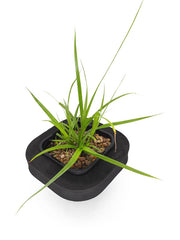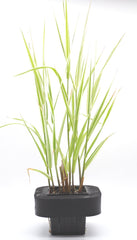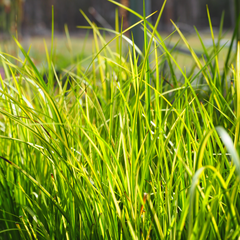Home
>
We Know Water Gardens Blog
>
Nature's Own Water Purifiers: Exploring the Numerous Benefits of Reeds, Grasses, and Rushes in Your Pond or Dam
Nature's Own Water Purifiers: Exploring the Numerous Benefits of Reeds, Grasses, and Rushes in Your Pond or Dam
on Feb 16, 2024
Are you looking for a natural and effective way to purify the water in your pond or dam? Look no further than the power of reeds, grasses, and rushes. These plants, commonly known as nature's own water purifiers, offer numerous benefits that can transform the health and quality of your water.
Reeds, grasses, and rushes have been used for centuries to naturally filter impurities from water. Their extensive root systems act as natural filters, absorbing nutrients and toxins, while releasing oxygen back into the water. This process helps to balance the ecosystem and create a healthier environment for aquatic life.
In addition to their purifying properties, these plants also provide a natural look to your pond or dam, adding depth and texture to the landscape. They can act as a natural barrier, helping to prevent erosion and maintain the structure of your water feature.
Whether you're a pond or a dam owner, incorporating reeds, grasses, and rushes into your water body can have a significant impact on its overall health and function. Discover the numerous benefits of these nature's own water purifiers and create a thriving aquatic habitat like never before.
The role of reeds, grasses, and rushes in water purification
Reeds, grasses, and rushes play a crucial role in the natural purification of water. These plants have adapted to thrive in wetland environments and have developed unique characteristics that make them excellent water purifiers.
One of the key functions of these plants is their ability to absorb excess nutrients from the water. Nutrient pollution, often caused by agricultural runoff and improper waste disposal, can lead to water degradation and the growth of harmful algae blooms. Reeds, grasses, and rushes absorb nitrogen and phosphorus, the main nutrients responsible for algal growth, effectively reducing their concentrations in the water.
Furthermore, these plants also act as natural filters, trapping sediment and pollutants suspended in the water. The dense root systems of reeds, grasses, and rushes create a physical barrier, preventing the movement of pollutants and allowing the water to pass through slowly. As the water passes through the roots, it undergoes a natural filtration process, removing impurities and contaminants.
Additionally, reeds, grasses, and rushes release oxygen into the water through
their roots. This oxygenation process improves the overall water quality by promoting the growth of beneficial bacteria and other microorganisms that consume organic matter and break down pollutants.
By adding reeds, rush or native grasses to your water garden, you can effectively enhance the water quality in your pond or dam, creating a healthier and more balanced ecosystem.
Benefits of using reeds, grasses, and rushes in your pond or dam locally in Australia
Incorporating reeds, grasses, and rushes into your water body offers a multitude of benefits that go beyond water purification. These plants provide a range of advantages that contribute to the overall health and aesthetics of your pond or dam.
One of the primary benefits is the enhancement of biodiversity. Reeds, grasses, and rushes provide habitat and food sources for various aquatic organisms, including Australian native fish, frogs, and insects. The dense vegetation offers shelter and protection, allowing these species to thrive. By creating a diverse and balanced ecosystem, you can support a wide range of wildlife and promote ecological resilience.
In addition to supporting biodiversity, reeds, grasses, and rushes also help to prevent erosion. Their extensive root systems anchor the soil and stabilise the banks of ponds and dams. This natural erosion control is particularly beneficial in areas prone to heavy rainfall or water flow (such as an natural watercourse running into a dam), as it helps maintain the structure and integrity of the water feature. Gardeners Garters (Phalaris arundinacea) develops a dense root system and is a good choice for stabilising the marginal areas of a pond or a dam wall area.
Furthermore, these plants add aesthetic value to your pond or dam. The vertical growth of reeds, grasses, and rushes adds depth and texture to the landscape, creating a natural looking environment. Their vibrant green foliage can provide a striking contrast against the water, enhancing the overall beauty of the water feature.
Moreover, reeds, grasses, and rushes act as a natural buffer, reducing the impact of pollutants and sediments entering the water body. They intercept and absorb pollutants before they reach the water, reducing the risk of contamination. This buffer zone also helps to regulate water temperature, providing a more stable and suitable environment for aquatic life.
By incorporating reeds, grasses, and rushes into your pond or dam, you can enjoy not only the benefits of water purification but also the advantages of a thriving and visually appealing aquatic habitat.
How reeds, grasses, and rushes remove contaminants from water
Reeds, grasses, and rushes have several mechanisms through which they remove contaminants from water. These plants have adapted to efficiently absorb and process pollutants, ensuring the purification of the water in which they grow.
One of the primary mechanisms is known as phytoaccumulation. Reeds, grasses, and rushes have the ability to take up contaminants from the water and store them in their tissues. This process involves the absorption of pollutants through the roots, followed by their transportation to the above-ground parts of the plants. Once in the above-ground tissues, the contaminants are stored, effectively removing them from the water.
Phytodegradation is another mechanism used by these plants to remove contaminants. Certain species of reeds, grasses, and rushes have the ability to break down or degrade pollutants through enzymatic processes. This degradation can occur within the plant tissues or in the surrounding rhizosphere, the soil environment influenced by the roots. Through phytodegradation, these plants can transform harmful substances into less toxic or non-toxic compounds, reducing their impact on the water. Gardeners Garters (Phalaris arundinacea) , Carex species, and Juncus effusus have been referenced as a wetland plants with the capability of removing heavy metals from water. The results published in Screening the Capacity of 34 Wetland Plant Species to Remove Heavy Metals from Water, highlighted the differences between 34 plants trialed as some removed more heavy metals than others. This could suggest to us in a home garden environment that planting a variety of reeds, rushes and grasses would be effective at safeguarding against deposits of pollutants such as heavy metals in our dams or ponds.
Additionally, reeds, grasses, and rushes contribute to the removal of contaminants through the process of rhizofiltration. Rhizofiltration involves the filtration of water through the root zone, where contaminants are physically trapped and absorbed by
the roots. The dense root systems of these plants act as natural filters, capturing suspended particles, sediment, and pollutants present in the water. This process helps to clarify the water and remove impurities, leading to improved water quality.
The combined mechanisms of phytoaccumulation, phytodegradation, and rhizofiltration make reeds, grasses, and rushes effective agents in the removal of contaminants from water. By harnessing these natural processes, you can create a self-sustaining water purification system in your pond or dam.
Golden Sweet flag (Acorus gramineus) is a great pond plant capable of carrying out this process. Its rhizomes are hard working when planted into shallow areas of ponds or the outskirts of a dam. It is tolerant of cold and will grow to 60cm H.
The process of natural water purification using aquatic plants
The process of natural water purification using aquatic plants involves the establishment and maintenance of a healthy ecosystem that supports the growth of reeds, grasses, and rushes. This process follows several steps to ensure the effective removal of impurities and the promotion of water quality.
The first step is the selection of suitable aquatic plant species. Different species of reeds, grasses, and rushes have varying growth habits, water requirements, and pollutant tolerance levels. It is essential to choose species that are well-suited to the environmental conditions of your pond or dam and can effectively remove specific pollutants of concern. View our range of Reeds, Grasses and Rush here.
After selecting the appropriate plant species, the next step is the establishment of the plants in your pond or dam. This involves preparing the planting area, which may include clearing any existing vegetation, loosening the soil, and creating planting pockets or beds. The plants should be strategically placed to maximise their coverage and filtration capabilities. It is important to ensure that the plants have access to sufficient sunlight and water, as these are essential for their growth and functioning.
Once the plants are established, regular maintenance and care are necessary to ensure their optimal performance. This includes monitoring water quality parameters such as nutrient levels, pH, and oxygen levels (more so if grown in a pond). Regular pruning or thinning of the plants may be required to prevent overcrowding and maintain their health. Additionally, removing any accumulated sediment or debris from the water surface can help prevent clogging and maintain the efficiency of the natural water purification system.
Over time, the reeds, grasses, and rushes will grow and spread, creating a dense and thriving vegetation cover. As the plants mature, they will become more efficient at removing contaminants from the water. It is important to note that the process of natural water purification using aquatic plants is not instantaneous. It requires patience and consistent monitoring to achieve the desired water quality.
By following these steps and implementing a natural water purification system using reeds, grasses, and rushes, you can effectively improve the water quality in your pond or dam, creating a healthier and more sustainable ecosystem.
Choosing the right reeds, grasses, and rushes for your pond or dam
When choosing reeds, grasses, and rushes for your pond or dam, it is crucial to consider several factors to ensure their success and effectiveness in water purification.
One of the key factors to consider is the environmental conditions of your water body. Different plant species have specific requirements regarding sunlight, water depth, soil composition, and nutrient availability. Assessing these conditions will help you select species that can thrive in your pond or dam and effectively remove pollutants.
Another important consideration is the specific pollutants of concern in your water body. Different plant species have varying capabilities in removing specific contaminants. For example, some species may be more efficient in removing excess nutrients, while others may have a higher capacity for trapping sediments or absorbing heavy metals. Understanding the pollutants present in your water will guide you in selecting the appropriate plant species to address those concerns.
Additionally, it is advisable to choose plant species that are native or well-adapted to your region. Native plants are more likely to be resilient to local environmental conditions and have established interactions with local wildlife. They can provide better ecosystem services and support local biodiversity.
By carefully considering the environmental conditions, pollutants of concern, and the suitability of plant species, you can choose reeds, grasses, and rushes that will thrive and effectively purify the water in your pond or dam.
Maintenance and care of natural water purification systems
To ensure the long-term effectiveness of natural water purification systems using reeds, grasses, and rushes, regular maintenance and care are essential. Proper maintenance will help sustain the health and performance of the plants, as well as maintain the overall water quality in your pond or dam.
One of the key maintenance tasks is monitoring water quality parameters. Regular testing of nutrient levels, pH, and oxygen levels can provide valuable insights into the overall health and balance of your water body. Monitoring these parameters allows you to detect any imbalances or issues that may arise and take appropriate actions to address them.
Regular pruning or thinning of the plants is also necessary to prevent overcrowding and maintain their health. Overgrown vegetation can lead to reduced oxygen levels and stagnant water, which can negatively impact the overall water quality. Pruning or thinning should be done selectively, removing excess growth while ensuring the plants maintain their filtration capabilities.
Removing accumulated sediment or debris from the water surface is another important maintenance task. Sediment and debris can accumulate over time, clogging the roots and reducing the efficiency of the natural water purification system. Regular removal of these materials helps to maintain the flow of water and prevent blockages.
Furthermore, it is important to monitor and control the growth of invasive plant species. Invasive species can outcompete native reeds, grasses, and rushes, reducing their effectiveness in water purification. Regular inspections and removal of invasive species will help maintain the integrity and functionality of the natural water purification system.
Regular inspections of the physical structure of your pond or dam are also important. Checking for signs of erosion, leaks, or other structural issues can help prevent any potential problems that may arise. Repairing or addressing these issues promptly will ensure the long-term sustainability of your water body.
By incorporating regular maintenance and care into your natural water purification system, you can ensure its continued effectiveness and enjoy clean and healthy water in your pond or dam for years to come.
Case studies: Success stories of using reeds, grasses, and rushes for water purification
Numerous case studies around Australia have demonstrated the successful implementation of reeds, grasses, and rushes for water purification in various water bodies around the world. These success stories highlight the effectiveness and benefits of utilising nature's own water purifiers.
One notable case study is the vegetation of the main lake in Mount Annan Botanical Garden in NSW. Here the reeds attract migrating birds in the spring-summer such as Latham’s Snipe (Gallinago hardwickii) as well as the Bailon’s Crake (Porzana pusilla) which is a small brown wetland bird.
By harnessing nature's own water purifiers, you can transform the health and quality of your water body, creating a thriving ecosystem that benefits both humans and wildlife.
Other natural water purification methods and their benefits
While reeds, grasses, and rushes are excellent natural water purifiers, there are other methods and techniques that can complement their effectiveness and provide additional benefits.
One such method is the use of floating wetlands or biofilters. Floating wetlands consist of floating platforms or rafts planted with a variety of aquatic plants, including reeds, grasses, and rushes. These floating islands provide additional surface area for plant growth and enhance the water purification capabilities. The plants in floating wetlands absorb excess nutrients and pollutants from the water, improving water quality. Our floating pond plant rings can be used to construct your own floating pond wetland. Simply attach a group of the pond rings using cable ties and allow them to act as a floating platform. These work well in dams that have fluctuations in water levels too as they will always remain where there is water.
Constructed wetlands are another effective natural water purification method. These wetlands are designed and constructed to mimic the natural processes of wetland ecosystems. They utilise a combination of reeds, grasses, rushes, and other wetland plants to remove contaminants from the water.
© weknowwatergardens 2024
Share






